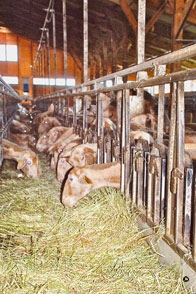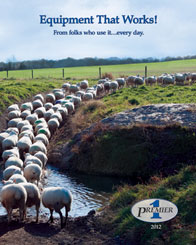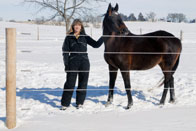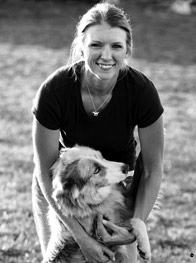|
MESSAGE FROM THE OWNER
Surprising insights from a study-tour of French sheep farms
A coach-load of US sheep folks toured French sheep farms in September. It included a full day at Tech-Ovin (a biennial French one-day event that brings together the latest sheep industry ideas and equipment).
I'm still trying to analyze what we saw and that which we “heard”. The hearing was difficult because our translator/guide chose not to bring along a megaphone so it was hard to hear him consistently.
In a nutshell?
| 1. | We visited 2 meat sheep farms, 1 dairy sheep farm (supplies the Roquefort cheese market), 1 dairy goat farm and 1 meat/wool farm. The latter was a case of chance and circumstance that occurred because it had a farm restaurant—that served us some of the best lamb I've ever encountered. |
| 2. | All except one had over 1000 ewes or dairy goats. Obviously we didn't expect to be taken to the smallest sheep farm. Nonetheless the scale of the operations was a surprise. |

All Terrain material handler. Common tool on European livestock farms. |

Manure spreader on the dairy goat farm. |
| 3. | All had a stunning amount of equipment including many tractors (latest), TMR (total mixed ration) wagons, huge manure spreaders, big square balers, heavy duty all-terrain material handlers, etc. |

Lacaune dairy sheep - feeding from a conveyor with mechanized mangers on each side. |

Feeding by conveyor. Note mechanized mangers again. |
| 4. | All had an equally stunning array of large barns-with automated feeders (2 fed grain with overhead robots that moved on long support pipes), in-barn hay-dryers that produced very high quality alfalfa hay, powered feed conveyors and mechanized manger feeding stations for 1000's of animals. |
| 5. | Most of the places visited (75%) were seriously expanding—while the French sheep industry, according to InterBev (France’s Meat and Livestock Assoc.), is shrinking—15% over last 10 years. The dichotomy puzzles. I sense the large are getting larger and the smaller operations are exiting. |
| 6. | Several used sponges for synchronized breeding and artificial insemination (with fresh semen) - on 1000's of ewes and/or goats per year. The cost/head was much less than in the USA. |
| 7. | We visited the largest French live sheep market (in Requista). It was very modern. But there was no auctioneer. Instead a bell sounds for a given class of sheep (light lambs, export lambs, ewes) and the seller walks to the front of his sheep pens. The buyers meet them there, brief man-to-man negotiations occur and it’s over—in less than 15 minutes. |
| 8. | No (that we could see) sheep handling yards. I suspect they rely on mechanized mangers to restrain the adult animals but I cannot be sure as that question wasn't, to my knowledge asked. |
| 9. | The dairy sheep (Lacaune) farm synchronized the breeding (AI) and the ewes lambed together in groups of 20. But there were no individual lambing jugs. I still marvel at that. They said it worked well. The lambs are weaned at 35 days and the ewes milked thereafter. (I think the latter was true but again, cannot be sure as it a was a large group with a less than wonderful translator.) |
| 10. | Aseasonal breeds appeared to be common. So lambing occurs throughout the year (3 in 2 yrs, 4 in 3 yrs, etc). Perhaps the resulting increased productivity per ewe explains/supports the extra buildings and equipment? |
| 11. | Not many of the lambs are pastured prior to slaughter. Most are kept inside and sold before they reach 80 lbs live-weight (some at 40-50 lbs). |
| 12. | Terminal sire breeds must produce lambs with saleable cuts with a high meat to bone ratio at an early age and low carcass weight. (Berrichon du Cher, Ile de France, etc.) |
| 13. | Compared to the USA there is both more regulation and more technical support from the French govt. and regional organizations for the sheep industry. |

Caussenard ewes. |
![[PDF]](http://premier1supplies.com/img/newsletter/icon-pdf.gif) Read more about Caussenard sheep » Read more about Caussenard sheep » |
| 14. | I include a pdf that you may download if you wish that provides yet more detail. It's a snapshot of one of several regional organizations. |
The tour left we US folks with these questions.
| 1. | How do the French sheep farmers afford all that equipment—far more than we US folks can afford? (We joked among ourselves that they have a tractor for every 25 ewes.) Best-guesses?
| • | Unlike US sheep producers the French have received decades of useful govt. subsidies—often amounting to over 33% of the annual "sheep income". Until recently these subsidies were based on euros per head—which is significant incentive to keep smaller ewes. |
| • | The market for lamb and sheep milk is more stable than in the USA. So sheep farmers are able to make long-term investments. |
| • | Both farm equipment and buildings can be fully expensed against taxes in the year of purchase. This policy (recently true in the USA) is a significant advantage to the profitable farms and/or those with off-farm taxable income—but it puts cash-poor new and/or smaller sheep farmers at a comparative disadvantage. |
|
| 2. | Why have most USA efforts at intensive sheep production similar to the French been failures? |
| 3. | Why do the French sheep and dairy goat farmers, unlike those anywhere else I've visited (UK, N. Zealand, Australia, Mexico, USA, Germany) so often feed sheep with mechanized mangers (see photos above)? It's a notable extra investment so they must save feed and make sheep handling easier. |
| 4. | Has anyone in the USA studied the Caussenard breed closely? No one on the trip had heard of it. Yes the wool is of no value (due to kemp)—but it has many characteristics that might be useful—can be raised indoors or out, relaxed temperament, reasonable frame, thrives on low-quality feed, aseasonal ovulation. |
Overall conclusion? It merits a second visit to some of the same farms—this time with more time at each stop and a much better translator.
Best Wishes To You All,
Stan Potratz, Owner
COMING SOON
2012 "Equipment That Works!" catalog

Start watching your mailboxes for Premier's 2012 "Equipment That Works!" Catalog. This year, in addition to our popular products that have pleased both Premier and our customers for years, we're offering new and improved heat lamp bulbs and goat collars & chains.
PREMIER TIP
Winter Horse Care Tips
By Kolby Freeman, Product Consultant for Premier
 When I get ready for winter, I start to think about my horses' feed, health and the condition of my facilities.
When I get ready for winter, I start to think about my horses' feed, health and the condition of my facilities.
| • |
Do I have enough hay/feed to get me through winter? |
| • |
Are the horses in good health or are they lacking groceries (weight)? |
| • |
How are my electric fences holding up? |
| • |
Are the stock tanks cleaned out and where did I put the tank de‑icer? It is important to make sure that there is enough hay, grain and mineral for a long winter. |
In Iowa you can never tell if winter will be a short 3 months or a long 6 months. In either case we need to be prepared. It's better to be overstocked on quality hay and clean bedding than not have enough materials on hand.
Hay should be offered free choice in a feeder that reduces waste. I feed grain during the winter just to meet the horse's needs, more so in extreme weather conditions. The feed rate is 1 to 2% of the horse's total weight (I feed closer to 1%). Use a horse measuring tape around the girth area to get an estimation of their weight. (A horse measuring tape is specifically designed for measuring height in hands and weight.) This is the perfect time to check body condition scores to see which one is lacking and which one is getting more than enough. It's hard to tell just by looking at them with the thick hair in the winter, so run your fingers over their ribs to check.
The body condition score is a rating on the amount of body fat on the horse. A very general scale is from 1 to 9, with a score of 1 being very emaciated and 9 being extremely obese. The score dictates the diet, which should be adjusted accordingly to the size, breed, exercise level and gender of the horse. For example, a pregnant mare has more nutritional demands than a gelding being maintained over winter. The main concern is to make sure every horse has enough fat cover to stay warm during winter. If a particular horse is falling behind and is showing signs of weight loss, such as bare ribs/backbone, take the proper action and supplement that particular horse. A big misconception is that grain added to the diet creates more body heat than hay. In truth, horses create more consistent body heat by eating roughage. The fermentation of the fiber in hay actually puts off more heat than the grains.
Horses' hooves are the most important part of them. I'm sure some of you have heard the saying: "No hoof, no horse." It can be hard on a hoofed animal when there is snow, ice, cold temps and moisture. I schedule a farrier every 6 weeks to come and trim. Shortly before the cold sets, I have the farrier take off the horses' shoes to help prevent the compaction of snow and slipping on ice. Keeping hooves regularly trimmed will help with this as well. Wet snow builds up on the sole and creates snowballs, making it hard on the tendons and hard for the animal to walk.
For the winter, I move my horses to a more secluded area on the south side of our barn, out of the wind and in an area where snow won't drift over the fences as much. I also make sure to check my electric rope fence line. This involves looking for cracked/broken/discolored insulators, frayed or burned rope, cracked gate handles, cobwebs and even bird droppings. Anything that does not belong there should be cleaned off, insulators replaced and frays/burns removed and spliced. I check my posts, looking for any bends, missing safety caps, etc. If the year has been extremely wet or dry, I check to see how the posts are holding in the ground. Are they loose when I wiggle them or do they stay in place? After everything has been checked and passes my inspection, I will re-tension the electric rope to ensure it is tight. Snow and ice may load down by fence, but once it melts away the fence will spring right back to where I tensioned it.
From my own personal experience, it seems my horses drink more water in the winter than in the spring and summer combined. It is extremely important to have clean, fresh water available for them 24/7. Snow on the ground does not mean they are eating it for water. It takes about 10 inches of snow to equal 1 inch of water. It would take 8 lbs of snow to equal 1 gallon of water. A horse's daily requirement for water is 5 to 15 gallon per day. Your horse would have to eat 40 lbs of snow to get the minimal 5 gallons! Even so, it takes a huge amount of heat energy to convert snow to water. That time should be spent eating and converting roughage to body heat.
It is equally important to keep the water tanks free of ice using an adequate tank de-icer. I know it is difficult to prevent all ice but there always needs to be an opening wide enough for the horse to get their muzzle in to drink. The ice can block access to water sitting lower in the tank, so keep it as full as possible. Water tanks are best sitting in a place that is draft free and blocked from snow and freezing rain.
It is a much easier to plan for these things now and be prepared for anything Mother Nature throws at you. Good luck to all and happy trails.
VIP ARTICLE
Keeping Chickens—Planning for Winter
Excerpts from articles written by Tim Daniels of poultrykeeper.com
Keeping chickens is a lot of fun, but as winter approaches, it's important for poultry keepers to think ahead. Winter can be a very difficult time for us. With the cold, dark mornings and dark evenings, many of us may be opening the chicken house before work in the dark and closing it when we get home in the dark. There is no better time than now to carrying out repairs to your hen house and run for winter.
Check your chicken house and run
The chicken run should be checked for wear and tear. It is important to check for gaps a predator could squeeze through. Most damage I have seen to runs has been where wire or runs are joined to houses. Any small hole or loose section of wire can be torn back easily by a fox or other predator. If you use an electric fence, make sure there are no short circuits to ground (branches, grass or anything else touching) because during the winter, you are more likely to have hungry predators about that are more willing to attempt to get into your chicken run.
When inspecting the chicken house, check for signs of water leaking into the house. Birds cannot stand drafts or being wet. Inspect the roof to make sure it is waterproof. Avoid using felt on the roof, as this provides the ideal environment for red mites to multiply. It is almost impossible to get rid of mites once they are under roof felt. Onduline roofing material is ideal as a replacement and is available in most DIY stores. It is lightweight and easy to use. If you are planning on treating or painting your chicken house, be sure to check that the product you are using is safe for birds. Under no circumstances allow birds back into the house until it is completely dry.
If, like me, you are at work during the day and unlikely to be around when it gets dark in the evening, an automatic chicken door is well worth the investment. This will open and close the door when it gets light/dark and you won't have the worry about lost birds.
Housing
Birds need clean bedding (ideally cleaned once per week). Ensure adequate ventilation is provided at a high level. Your birds (especially chickens) must not be in a direct draft. The main openings on my chicken house face the north but it's normally during the winter months that we can get a bitter north wind blowing. I cover this opening to keep out the wind and rain but still leave a small high-level vent.
Feeding
There are a number of myths that circulate from time to time about winter feeding. Some poultry keepers tell me they only feed corn or wheat to their chickens over the winter months to save money when they are not laying. This, I believe, is false economy because it will delay the onset of laying, the chickens being unable to build up enough calcium and essential nutrients in their body. Lack of calcium leads to thin-shelled eggs and poor general condition.
Water
The winter months can be hard work when drinking water needs de-icing in the mornings. There are several methods used by poultry keepers to help ease the burden. Your birds need to have fresh drinking water at all times during the day but you can remove water containers at night, refill them and keep them in a frost-free building overnight. The next morning, quickly return them to the chickens, along with any feed containers you have taken in. This is far easier than trying to melt a solid block of water in the morning! Another method I have used with success is wrapping old towels around my hanging water containers if I think there may be freezing temperatures. This keeps the water from freezing unless it's a really cold night.
Remember that ducks and geese need constant access to clean water for washing. A lack of water and excess of mud can cause a condition known as wet feather, which is a problem that needs to be avoided.
Feeders and water containers
Feeders and water containers should of course be cleaned regularly. Now is a good time to ensure they are in good working order and order a spare to keep indoors. Why keep a spare indoors? Well, when you go out one morning in a hurry to find there's been a hard frost and your birds are looking for water, hopefully you will thank me.
There are a number of different water containers available. Don't be tempted to buy huge water containers for a few birds since they need fresh water daily (or at least every other day).
Vermin
Remember at this time of year, there are hungry rats and mice around. Take care with the storage of feeds and keep an eye out for the tell tale signs of vermin. Don't ignore them, or you will suddenly find you are overrun.
Grazing rotation
If your chickens are kept on the same patch of ground, once the grass stops growing in late fall you will find it will soon turn to mud. It is worth rotating their grazing ground if you can. Some runs and houses can be moved but if you have a fixed run in a corner of the garden, you might consider dividing it to allow one half to recover before the grass stops growing. I keep my chickens on a strip of land that I have crudely divided into several sections. As one area gets worn, I move their house along or open up a picket gate to allow them onto fresh ground. I mix some of my smaller flocks after the breeding season so the runs get a rest and can recover before the grass stops growing. Rotating your poultry's grazing will also avoid a buildup of endo-parasites (worms) on the ground (and therefore a buildup in your birds).
Looking after your grass
The grass is always greener on the other side! I try to save a small area of grass for my birds to use over winter to save turning their summer runs into mud. Giving the ground a break like this helps to keep disease and internal parasites under control as well as keeping the grass alive. Portable houses and runs are especially good for getting a change of grass every week or so.
Frozen comb in roosters
When the temperature drops and we have a hard frost, roosters with large combs can get frostbite to their combs. The result is parts of the comb and/or wattles that turn black and eventually die off. This can occasionally cause infertility during the breeding season the next spring. The problem normally occurs with birds that have large combs, such as leghorns. Rose comb birds are not affected and hens don't have this problem because they sleep with their heads tucked under their wings during cold weather.
The cockerel's comb is most at risk when the humidity in the house is high and the temperature drops below freezing outside. If your chickens live in a well-insulated house or one with poor ventilation, this tends to be when they are at a greater risk.
How does a rooster get a frozen comb?
If you wear glasses, you will be well aware of how glasses steam up when you entering a house after being outside in the cold. This is the same thing that happens to your rooster's comb. The chicken house is kept warm and humid by all of those sleeping chickens and droppings. In going back and forth from inside to outside and back in again, the rooster gets moisture on his comb from the warm humid air inside and then goes out into the cold where his comb freezes.
What can be done to prevent a frozen comb?
The chicken house should be kept well ventilated (but not drafty) even during cold weather. Chickens can take the cold, assuming they are in good health and fully feathered. Vaseline can be rubbed on a rooster's comb in the mornings or if he isn't too easily caught, when he is roosting at night.
EMPLOYEE SPOTLIGHT
Kolby Freeman
 |
This month's featured employee is Kolby Freeman, who joined Premier more than two years as a product consultant. Kolby says the best part about her job is helping answer customer questions about products or livestock. "I like troubleshooting with customers when a fence or energizer isn't working properly. I think it's the challenge of it all that makes the job more exciting! I really enjoy going to shows and fairs to exhibit Premier products and get feedback from customers, see the new products available and talk with other vendors."
Kolby says she enjoys working with the team at Premier. "You can't find better people to work with than at Premier. Everybody has such wide knowledge of all the products, and if they don't know, they will sure find out for you, always honest about products pros and cons. In working at Premier, I find a lot of the products that I also use at home, so I can talk to customers about my personal experience with them. Not too many companies can say that."
Kolby and her husband, Brad, live in Mt. Pleasant, IA with Peyton, their 2-year-old daughter, and Brad's son, Parker, age 4. Also part of the family are two dogs—an Aussie named Brindle and a Border Collie/Great Pyrenees-cross named Private Stryker. Kolby owns two paint horses, Rosie and Gauge, and a quarter horse named Diesel. They also have sheep, chickens, turkeys and ducks at their farm.
Her special interest is breaking horses, training barrel horses and competing in rodeo/barrel races. "I am addicted to the speed and the rush of riding fast horses. It's an adrenaline rush." Kolby has one or two horses a year that she trains or breaks to ride. She and Brad board a few horses through the summer as well. She is a member of the Iowa NBHA District 5, Better Barrel Races (BBR), International Barrel Racing Association (IBRA), American Paint Horse Association (APHA) and American Quarter Horse Association (AQHA). Another association/club Kolby and her mom are starting in southeast Iowa is Cowboy Mounted Shooting. "If you think running barrels is fun, try shooting a gun off horseback. The object is getting through an obstacle course with precision and speed. The quickest horse/rider team through the course with the most hit targets wins."
She and Brad are working toward the goal of having their own purebred flock of Suffolk and Dorset sheep. "I've wanted to raise market and club lambs ever since 4-H and FFA. I loved showing livestock and this was a way to keep me still involved. Competition is just in my blood, I guess."
Kolby's philosophy: "I believe in giving your all and standing up for what you believe in. Can't is a mindset—you can do what ever you put your mind to. The strongest thing in life is your willpower."
|